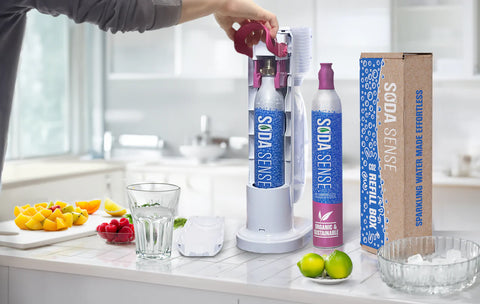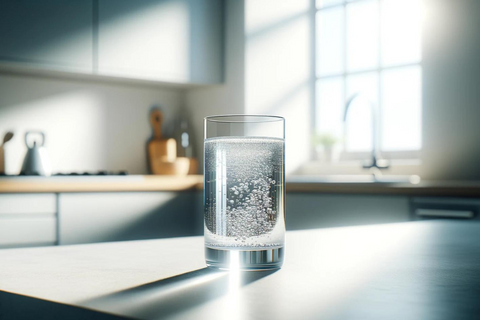
How to Make Sparkling Water at Home

How to make sparkling water at home
There are a few popular ways to make sparkling water at home including using a sparkling water maker or DIY carbonation methods. In this guide, we will explore both methods and discuss the equipment needed, as well as some tips for getting the best results.
Soda Sense offers trusted, easy-to-use CO2 refills delivered straight to your doorstep, we ensure that making endless sparkling water at home is not just a tasty choice, but also an incredibly convenient and eco-friendly one.
Table of contents
3 Ways to make sparkling water at home
- Using a sparkling water maker
- Using a plastic bottle
- Using dry ice
Using a sparkling water maker
Using a sparkling water maker is a straightforward, safe, and efficient way to create bubbly water at home. This device is designed to seamlessly infuse carbon dioxide into your drink, providing a consistent and delightful fizz every time.
Materials:
- Sparkling water maker
- Carbon dioxide cylinder
- Water bottle (compatible with the sparkling water maker)
Steps:
- Fill the water bottle with cold tap water up to the indicated fill line. Using cold water helps achieve better carbonation results.
- Attach the filled bottle to the sparkling water maker by screwing or snapping it into place, depending on the model.
- Ensure that the carbon dioxide cylinder is properly installed in the machine. Follow the manufacturer's instructions for precise installation.
- Press the carbonation button or lever on the device to release CO2 into the water. The amount of carbonation usually depends on the number of presses; refer to your machine’s guidelines for desired fizz levels.
- Once carbonation is complete, gently unscrew or release the bottle from the sparkling water maker.
- Carefully pour your homemade sparkling water into a glass and savor the refreshing bubbles.




The SENSEation Sparkling Water Maker
Using a plastic bottle
Carbonating water at home using a plastic bottle is a simple and cost-effective method. This technique allows you to enjoy fizzy water without the need for expensive equipment.
Materials:
- Plastic bottle
- Carbon dioxide charger or cartridge
- Tube
- Main chamber
- Head with dispensing lever
Steps:
- Fill the plastic bottle with tap water, leaving a small gap at the top to accommodate gas expansion.
- Securely insert the tube into the bottle's base.
- Screw the head onto the bottle tightly to prevent gas leakage.
- Place a carbon dioxide cartridge into its holder, then position the holder in the slot on the head. This will pierce the cartridge, allowing CO2 to flow into the water through the tube.
- Gently shake the bottle for 10 to 15 seconds to evenly distribute the carbon dioxide.
- Once the water is fully carbonated, remove the cartridge holder from the head.
- To serve, press the dispensing lever on the head to release your homemade sparkling water. Enjoy your refreshing fizzy drink!

Using dry ice
Using dry ice to make sparkling water is a fascinating and effective method, though it requires caution due to the extremely cold temperatures involved. Dry ice is simply the solid form of carbon dioxide, and when it sublimates, it releases CO2 gas, which can carbonate your water.
Materials:
- Dry ice
- Thick gloves (to handle dry ice)
- Plastic or glass bottle with a screw cap
- Cold water
Steps:
- While wearing thick gloves, break the dry ice into small, manageable pieces. Ensure you handle the dry ice properly to avoid skin burns.
- Fill your bottle with cold water, leaving some space at the top for the dry ice.
- Carefully add a small piece of dry ice to the bottle. Start with a tiny piece to avoid over-pressurizing the container; you can always add more if needed.
- Screw the cap loosely on the bottle to allow some gas to escape and prevent pressure build-up, which can be dangerous if left unchecked.
- Wait for the dry ice to fully sublimate, shaking the bottle gently to facilitate even distribution of the gas.
- Once the dry ice has completely turned into gas and dissolved in the water, tighten the cap, give the bottle a final shake, and your homemade sparkling water is ready.
- Open the bottle carefully, as the carbonation creates pressure. Pour your sparkly refreshment into a glass and enjoy!
Caution: Handle dry ice carefully, and ensure adequate ventilation while the dry ice sublimates. Always prioritize safety in this carbonation method.
A soda maker is undoubtedly the best way to carbonate water at home. It offers not just the right level of carbonation but also ensures safety and consistency. Plus, with a soda maker, you have complete control over the carbonation level and flavor, making it a versatile tool for creating your perfect sparkling water.
With Soda Sense, you can refill and exchange CO2 canisters with ease, ensuring that you're always ready to enjoy your favorite fizzy beverages. Make the smart choice and switch to using a soda maker for all your carbonation needs.
Related Read: Choosing the Right Soda Maker: A Comprehensive Buying Guide

Myth busting making sparkling water at home
In the realm of carbonated water, there are countless myths floating around. However, it's crucial to sift through the noise and uncover the most effective and safe methods. Join me as we debunk these myths and shed light on the truth.
Myth 1: Adding salt or baking soda
You might have heard that adding salt or baking soda to water can create fizz. However, while these ingredients might cause some bubbles, they won't provide the level of carbonation you desire in your sparkling water. Additionally, they could drastically alter the taste, leading to a less-than-satisfactory beverage.
Myth 2: Shaking the bottle
While shaking a bottle can create bubbles, it falls short in terms of carbonation compared to a soda maker. Furthermore, this method carries inherent risks, as it may unexpectedly result in the bottle bursting open.
How long does sparkling water remain carbonated?
Homemade sparkling water should be stored in airtight containers or glass bottles and kept in the refrigerator for up to three days.
After that, it’s best to discard it and start fresh with a new batch. The level of carbonation may decrease over time, but it will still be safe to drink.

The history of homemade sparkling water
The history of sparkling water is as fascinating as the bubbling drink itself. Carbonated water, as we know it today, can trace its origins back to the 18th century when natural mineral water was highly prized for its supposed health benefits. However, it was not readily available to everyone. This led to the pioneering scientist, Joseph Priestley in 1767, to invent a method to artificially produce this effervescent water. His invention sparked a revolution in the beverage world and laid the groundwork for the modern soda industry.
The 19th century saw the birth of 'soda fountains' in drug stores, marking an important milestone in the history of carbonated water. These became social hubs where people gathered to enjoy a refreshing glass of 'soda water'. The invention of home soda makers in the 20th century allowed people to create their own sparkling water at home, democratizing access to this delightful beverage.
Today, making sparkling water at home has never been easier, thanks to advancements in technology and products like Soda Sense, which offer trusted CO2 refills right to your doorstep. The convenience, combined with the ability to customize flavors and control the amount of carbonation, makes homemade sparkling water an excellent choice for beverage enthusiasts everywhere.
Related Read: Sparkling Water vs Still Water: What's the Difference?

Summary
Creating delightful sparkling water at home has never been simpler. With a soda maker, you can relish the invigorating effervescence of store-bought beverages in a matter of seconds - free from any unhealthy additives or preservatives.
Moreover, it presents a cost-effective opportunity to save money while making a positive contribution to the environment. So why not give it a whirl? You won't be disappointed!
Recommended reading

How to Give Back During Thanksgiving 2025
Key takeaways Thanksgiving is a time to express gratitude and share with those in need. From volunteering at local shelters to donating food and essentials, there are numerous ways to give back to...

What Does Carbonation Do to Your Body?
What does carbonation do to your body? Carbonation alone typically has minimal effects; however, it can cause bloating and discomfort for some, and it may worsen acid reflux due to carbon dioxide ...

What Are the Health Benefits of Sparkling Water?
Summary Sparkling water isn't just a refreshing drink—it comes with surprising health benefits too. From aiding digestion to improving hydration, discover how sparkling water can be a healthy addi...